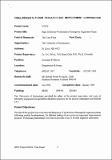| Organisation | University of Queensland (UQ) |
| Author | Bower, R |
| Author | University of Queensland |
| Date Accessioned | 2013-11-28 |
| Date Available | 2013-11-28 |
| Issued | 1994 |
| Identifier | http://hdl.handle.net/11079/12969 |
| Abstract | The efficiency of gene transfer into embryogenic callus of sugarcane has been increased tenfold by optimisation of particle bombardment conditions, and there is a corresponding increase in stable transformation frequencies. The method routinely yields approximately 2 independent transgenic plants per cm2 of bombarded embryogenic callus for sugarcane varieties anlenable to tissue culture. Genes coprecipitated on separate plasmids are cotransformed at high efficiency, which will facilitate introduction of agronomic genes. Materials needed for recovery of transgenic plants can be halved through improved selection protocols, allowing the recovery of hundreds of independent transformed plant lines. The improved method is now in use in BSES and CSIRO as well as UQ laboratories Since the completion of this project, the transformation system has been shown to be effective on a range of major commercial varieties, and over 70 lines from seven cultivars are currently in field trials. |
| Language | en |
| Part of Series | Internal Report; 1994 UQ012 |
| Subject | Gene transfer |
| Subject | Transgenic sugarcane plants |
| Subject | Sugarcane improvement |
| Subject | Stable transformation frequencies |
| Subject | Transformation system |
| Subject | Improved selection protocols |
| Subject | Transformation techniques |
| Subject | Sugar accumulation |
| Subject | Transformation efficiency |
| Subject | Molecular improvement |
| Subject | DNA into sugarcane embryogenic callus cells |
| Subject | ANT marker gene system |
| Subject | Microprojectile delivery, osmotic treatments |
| Subject | Varieties |
| Subject | Plant breeding |
| Title | High efficiency production of transgenic sugarcane plants |

